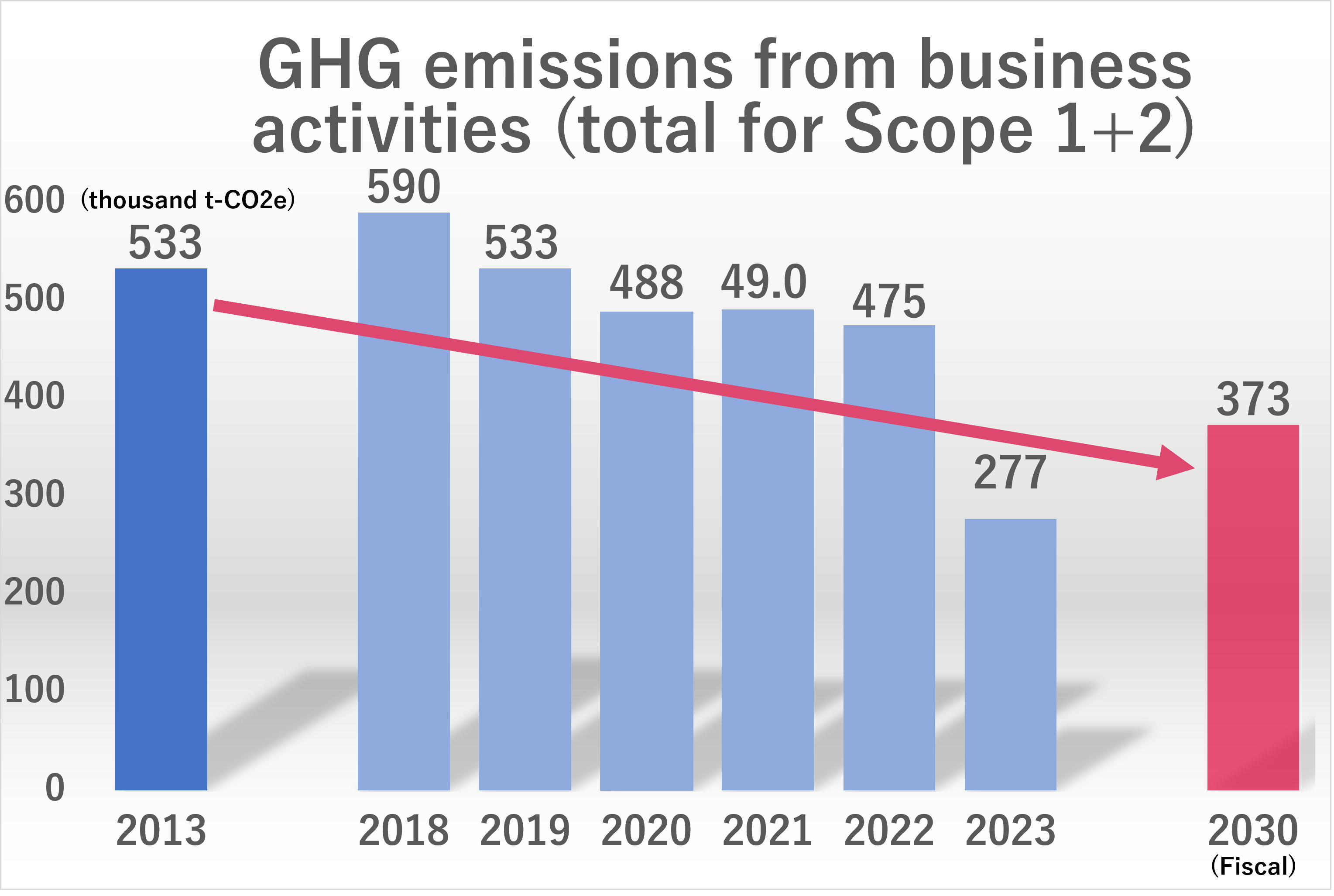In light of proposals by the Task Force on Climate Related Financial Disclosures (TCFD), OSAKA SODA has decided on the following governance, strategy, risk management, and metrics and targets.
Osaka Soda established a Sustainability Committee to receive and oversee reports on climate change. This committee also formulates sustainability policies, strategies, and measures for various departments, monitors the state of KPI achievement related to initiatives and the materiality defined in the SDGs, and regularly submits reports and makes recommendations to the Board of Directors.

Osaka Soda used the 1.5‐2℃ and 4℃ scenarios to identify risks associated with the transition to a decarbonized society (transition risks) and risks associated with physical impacts of global warming (physical risks), respectively.
Under the 1.5/2℃ scenario, transition risks are assumed to be relatively higher than physical risks, while under the 4℃ scenario, physical risks such as reduced capacity utilization and unstable resource supply due to frequent disasters such as typhoons and floods are assumed to be relatively higher.
Given this, OSAKA SODA has identified the following risks and opportunities related to climate change that are important to us, and has formulated action policies for these.
|
Risk/Opportunity Type |
Period of Occurrence |
Business Impact |
Action Policy |
||
|
Transition risks (※1) |
Policies and regulations |
Increased carbon price and other regulatory compliance costs |
Short term |
High |
|
|
Increased offset credit prices |
Long term |
High |
|||
|
Increased prices and difficulties in procurement of some materials due to regulations |
Short term |
Medium |
|
||
|
Markets |
Decreased demand for commercial products with high environmental impact |
Short term |
Medium |
|
|
|
Physical risks (※2) |
Acute |
Decreased capacity utilization of business sites due to sudden disasters |
Medium term |
Medium |
|
|
Stopped operations due to damage in the supply chain |
Medium term |
Medium |
|
||
|
Unstable supply of natural resources, water, electricity, raw materials, etc. |
Medium term |
Medium |
|
||
|
Chronic |
Medium term |
Medium |
|||
|
Opportunites |
Products and services |
Increased subsidies for the development and implementation of environmentally friendly technologies |
Short term |
High |
|
|
Increased demand for materials, components, and solutions for environmentally friendly equipment |
Short term |
Medium |
|||
|
Captured business opportunities by developing environmentally friendly technologies ahead of competitors |
Short term |
Medium |
|||
|
Markets |
Enhanced corporate image by promoting disclosure of climate-related information |
Short term |
Medium |
|
|
- Assumed to occur most significantly under the 1.5/2℃ scenario
- Assumed to occur most significantly under the 4℃ scenario, etc.
At Osaka Soda, appropriate response to climate change is an important issue and is discussed in the relevant departments. These discussions are regularly reported to the Board of Directors.

Having selected greenhouse gas (GHG) emissions as a metric to evaluate climate change, we aim to reduce fiscal 2030 GHG emissions (total for Scope 1+2) 30% compared to fiscal 2013.
|
GHG emissions [thousand t-CO2e] |
|||
|
Scope 1 |
Direct emissions |
52.8 |
|
|
Scope 2 |
Indirect emissions from energy sources |
(Market-based) |
224.5 |
|
(Location-based) |
277.7 |
||
|
Scope 3 |
Other indirect emissions |
326.9 |
|
GHG protocol |
GHG emissions [thousand t-CO2e] |
|
|
Category 1 |
Purchased goods and services |
176.7 |
|
Category 2 |
Capital goods |
18.5 |
|
Category 3 |
Fuel-and energy-related activities (not included in Scope 1 or Scope 2) |
89.7 |
|
Category 4 |
Upstream transportation and distribution |
39.4 |
|
Category 5 |
Waste generated in operations |
1.5 |
|
Category 6 |
Business travel |
0.5 |
|
Category 7 |
Employee commuting |
0.6 |
|
Category 8 |
Upstream leased assets |
ー ※1 |
|
Category 9 |
Downstream transportation and distribution |
ー ※2 |
|
Category 10 |
Processing of sold products |
ー ※2 |
|
Category 11 |
Use of sold products |
ー ※2 |
|
Category 12 |
End-of-life treatment of sold products |
ー ※2 |
|
Category 13 |
Downstream leased assets |
Excluded※3 |
|
Category 14 |
Franchises |
Excluded※3 |
|
Category 15 |
Investments |
Excluded※3 |
*1 Not calculated since included in Scope 1 and 2
*2 Not calculated since it is difficult to collect activity data as they are used by many customers and for many purposes
*3 Excluded since target business is not conducted
【Emissions intensity used】
When calculating Scope 1 and 2 emissions, Osaka Soda uses coefficients from the Ministry of the Environment’s system for calculating, reporting, and making public GHG emissions. When calculating Scope 3 emissions, emission factors from IDEA Ver.3.4 or the Ministry of the Environment’s Emission Intensity Database For Calculating GHG Emissions Throughout the Supply Chain V3.4 are used.
【Scope of calculations】
Scope 1, 2: Osaka Soda Group domestic business sites
Scope 3 (categories 1, 2, 4, 6, 7): Osaka Soda domestic business sites
Scope 3 (categories 3, 5): Osaka Soda Group domestic business sites
